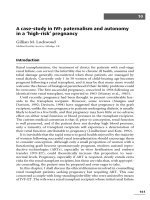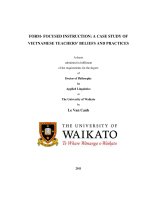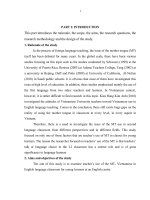Case Study: chinas low carbon city project
Bạn đang xem bản rút gọn của tài liệu. Xem và tải ngay bản đầy đủ của tài liệu tại đây (322.45 KB, 4 trang )
Low Carbon Green Growth Roadmap for Asia and the Pacific
CASE STUDY
100 cities working to become low-carbon habitats
China’s low-carbon city project
Key point
•
The principle of eco-efficiency – producing more while consuming less and polluting less – has been
mainstreamed into the development of cities in China to manage the crisis of rapid urbanization and
promote long-term growth.
There was a problem…
The migration of Chinese people from remote provinces and villages to cities began in the 1980s. Since then, the
urbanizing process has provided millions of workers who helped buttress the fast economic growth. Hardly surprising however, the urbanizing process also moved new challenges such as resource shortages and environmental
deterioration into all the cities, from small up to Beijing and Shanghai and especially as migration sped up in the
mid-1990s. As of 2009, the energy intensity of the Chinese urban centres was 2.75 times the world average1 and
was expected to be higher in the coming decades. Shifting the direction of the city development for ecoefficiency was imperative for the survival of cities.
What was done?
In July 2010, the Government’s National Development and Reform Commission launched a pilot project to construct low-carbon cities in five provinces (Guangdong, Liaoning, Hubei, Shanxi and Yunnan) and eight cities
(Tianjin, Chongqing, Shenzhen, Xiamen, Hangzhou, Nanchang, Guiyang and Baoding (figure 1)). The good
practices pursued through the pilot projects are intended to be applied to other Chinese cities after the project.
Figure 1: China’s five low-carbon pilot provinces and eight cities
Source: ESCAP, based on the source from the National Development and Reform Commission, China
1
The National Bureau of Statistics of China, China Statistics Yearbook 2010. Available from www.stats.gov.cn/tjsj/ndsj/2010/indexch.htm
(accessed 18 July 2011).
Low Carbon Green Growth Roadmap for Asia and the Pacific : Case Study - China’s low-carbon city project
The heavy burden on resources had forced many cities to rethink their urban plans even before the government
introduced its national response. In scattered corners, urban planners began promoting low-carbon directions
for their cities or at least adaptation responses to climate change issues. For instance, city planners in Baoding,
Hebei Province, released a development plan for a low-carbon city in December 2008. Urban planners in Tianjin
municipality announced their plan to address climate change in March 2010.2 Currently, nearly 100 other cities
are also willing to construct low-carbon environments.
The plan’s purpose is to encourage cities to find new strategies for economic growth and improving people’s
quality of life. The plan requires the following:3
Creating a low-carbon development plan. The plan integrates the adjustment of the industrial structures,
the optimizing of the energy structures, improving energy saving and efficiency and increasing the
carbon sink.
Setting supportive policies for low-carbon green growth. Market mechanisms are encouraged to
achieve the greenhouse gas emission-control targets. Promoting of green building and public transport
are part of them.
Establishing a low-carbon industrial system: This includes green innovation and R&D, installation of lowcarbon technologies into industrial process, nurturing green business in energy efficiency and renewable
energy sectors.
Establishing a greenhouse gas emission statistics and management system. Data collection and
accounting system need to be set up along with strengthening the skills of staff to proficiently manage it.
Advocating lifestyle and consuming patterns of low carbon green growth. Education and advertising
campaigns on the imperative of low-carbon lifestyles that target both policymakers and the general
public are required.
•
•
•
•
•
Results
Given the pressure as well as incentives from national government, many cities had begun moving towards
eco-city development even before the project. The pilot project to construct low-carbon cities in the selective
areas thus became a good opportunity for the participating cities to showcase their achievements in a spotlight
that had not been there before.
Still, whether due to previously set regional targets relating to carbon and energy intensity or greater impetus
through the low-carbon city project, as the following table explains, many changes are taking place with industrial structures, building energy codes, heavier promotion of public transport, ecologically efficient vehicles and
non-motorized transport and increases in renewable energy generation and use.
Table 1: Targets, programmes and activities for low-carbon environments, by city
City
Tianjin
Chongqing
2
3
Target
Major programmes
Activities
By 2015, the carbon intensity, Combating Climate Change Sino-Singapore Tianjin Eco-city, a
compared with 2010, reduced by Plan
collaboration with Singapore and Japan
15.5 per cent
to build a model low-carbon city.
By 2015, the energy intensity,
compared with 2010, reduced by 15
per cent
By 2015, the proportion of forest
cover increased to 23 per cent or
more
By 2015, the carbon intensity
Accelerating the development of lowdropped to less than 1.15 ton per
carbon transport, green buildings and
10,000 yuan GDP
green energy
By
2015,
non-fossil
energy
accounts for more than 30 per cent
of total energy consumption
By 2015, the proportion of forest
cover increased to 38 per cent or
more
TThe Climate Group, The Clean Revolution in China: Cities (London, 2010).
People's Republic of China, National Development and Reform Commission website “The Notice of the Development of Low Carbon
and Low Carbon City Pilot” (2010). Available from www.sdpc.gov.cn/zcfb/zcfbtz/2010tz/t20100810_365264.htm (accessed 18 July 2011)
[Chinese language website].
Low Carbon Green Growth Roadmap for Asia and the Pacific : Case Study - China’s low-carbon city project
Shenzhen,
Guangdong
Province!
Shenzhen: Medium- and
Long- Term Low-Carbon
Development Plan (2011–
2012)
Shenzhen
2010
EnergySaving Emission-Reduction
Work Plan
Action Plan for Speeding up
the
Elimination
of
the
Outdated Industrial Capacity
in Guangdong
Xiamen, Fujian By 2020, the carbon intensity, The Outline of Building a
Province
compared with 2005, reduced by Low-Carbon City in Xiamen
60 per cent
By 2020,the total amount of carbon
dioxide emission less than 68.64
million tons
Hangzhou,
Opinions on Constructing a
Zhejiang
Low-Carbon
City
in
Province!
Hangzhou
Nanchang,
Jiangxi
Province
Guiyang,
Fujian
Province
Baoding,
Hebei
Province
By 2015, the carbon intensity
decreased by 38 per cent,
compared with 2005
By 2015,non-fossil energy accounts
for more than 7 per cent of total
energy consumption
By 2015, the proportion of forest
cover increased to 23 per cent or
more
By 2020, the energy intensity lower
than 1.3–1.4 tons of standard coal,
down by 40 per cent compared with
2005
By 2020, the carbon intensity
decreased from 3.77 ton per 10,000
yuan GDP in 2005, to 2.07–2.24 ton
per 10,000 yuan GDP
By 2020, the carbon intensity
(carbon dioxide emission per unit
GDP),
compared
with
2010,
reduced by 35 per cent
By 2020, the carbon dioxide
emission below 5.5 ton per person
Low-carbon Development Promotion
Law in special economic zones and a
national model low-carbon city
Strictly control the greenhouse gas
emissions from the transportation,
residential buildings, public buildings
and manufacturing
Plan to build a six-in-one low-carbon
city: the
low-carbon economy, lowcarbon
architecture,
low-carbon
transportation, low-carbon lifestyle, lowcarbon environment and low-carbon
society
Nanchang: An Action Plan for The first regional carbon emission and
Promoting the Low-Carbon energy-consuming monitoring system
Economy and Building a Low- and carbon emission publishing system
Carbon City
in People’s Republic of China
Jiangxi: 2010 Contingency
Plan for Energy Conservation
and
Emission
Reduction
Monitoring and Early Warning
System
Action Plan for Low-Carbon Exploring and developing a carbon
Development in Guiyang emission trade system under the current
(outline) 2010–2020
conditions (trial operation)
Implementing Suggestions on Focusing on creating the “Chinese
Building Low-Carbon City in electricity valley” and “solar city”
Baoding
Opinions on Constructing
Baoding as a Solar City
Source: The Climate Group, China Clean Revolution Report III: Low Carbon Development in Cities (London, 2010). Available from
www.theclimategroup.org.cn/publications/2010-12-Chinas_Clean_Revolution3.pdf [In Chinese language]; Clean Air Initiative in Asia Centre
(CAI-Asia Centre), Low Carbon Cities and Development Plan-8 Pilot Cities (Dalian, 2011).
Lessons learned
Low-carbon city development should be pursued in accordance with a broader national framework aimed at
low carbon green growth. Even though the pilot project to build low-carbon cities became a trigger to encourage city planners to come up with action plans for low-carbon development, there were national energy intensity targets impressing upon city governments for change. The energy-intensity reduction targets established at
the municipal level are based on the national goals set under the Twelfth Five-Year Plan (2011–2015), which was
the initial motivation on most cities to improve their energy efficiency in production and consumption.
Providing incentives is critical to attract cities to follow through on complementary policies. Many Chinese cites
regard the participation in the project as an opportunity to nurture a greener economic engine due to the
various programmes offering support. For instance, the Promoting New Energy Automotive Industry Development Policy, introduced by the Ministry of Industry and Information Technology, facilitates the development of
local low-carbon businesses. In Guangdong Province, special funds have been established for helping lowcarbon industries development. Under the Demonstration and Popularization Project of Renewable-Energy
Low Carbon Green Growth Roadmap for Asia and the Pacific : Case Study - China’s low-carbon city project
Building Application, participating cities are granted around US$70 million from the central Government.
Designating a coordinating body to guide the low-carbon city projects can better assist local government to
handle cross-sector issues. The pilot project involved many supplementary policies across sectors, including
those that related to the national emissions reductions targets and those looking to boost green business. Management of the eco-city project was delegated to the National Development and Reform Commission, which
has responsibility for integrated national socio-economic planning and producing the Five-Year Plans.
Further reading
China Clean Revolution Report III: Low Carbon Development in Cities (New York, The Climate Group, 2010). Available from www.theclimategroup.org.cn/publications/2010-12-Chinas_Clean_Revolution3_Summary.pdf









